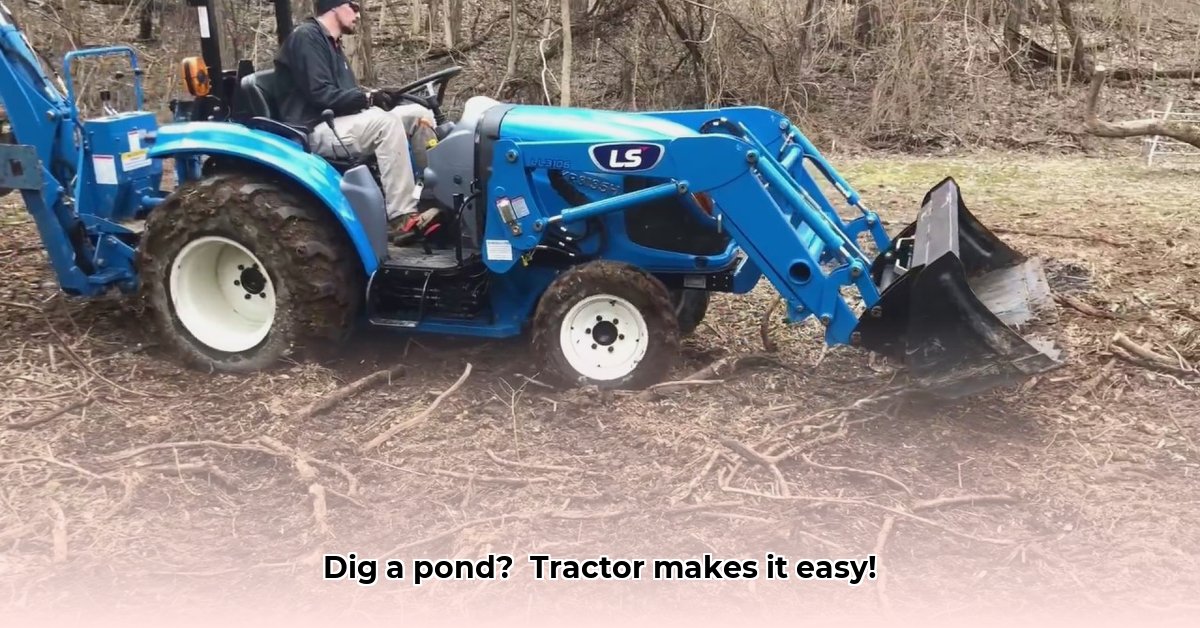
This comprehensive guide provides a step-by-step approach to digging a pond using a tractor, covering planning, equipment selection, excavation, safety, and troubleshooting. Whether you're building a small frog pond or a larger swimming area, this guide will equip you with the knowledge and techniques for a successful project. For a list of helpful tractor implements, see this helpful resource.
Planning Your Pond Project: Laying the Foundation
Before starting your pond excavation, meticulous planning guarantees a safe and efficient project. This involves several key steps:
Site Selection and Assessment
- Determine Pond Size and Shape: Consider the desired size (small frog pond or larger swimming area) and shape (simple or complex). A simple design is generally easier to build.
- Soil Analysis: Evaluate the soil type (clay, sand, rock). Rocky or clay soils require more powerful equipment and potentially a different excavation approach.
- Utility Line Marking: Contact your local utility companies (dial 811 in the US) to have underground lines marked before digging. This prevents serious accidents.
- Permitting: Check local regulations regarding pond construction. Permits might be required depending on your location and pond size.
- Drainage Planning: Plan water inflow and outflow to prevent stagnation. Consider natural drainage patterns and potential water sources. Proper drainage is crucial for a healthy pond ecosystem.
Detailed Design and Measurement
- Detailed Sketch: Create a detailed sketch or plan specifying pond dimensions, depth, and shape. Include areas of different depths for aquatic plants and wildlife.
- Stake and String Marking: Use stakes and string to mark the pond's boundaries on the ground. This provides a visual guide during excavation.
- Consider Soil Compaction: For clay or rocky soil, consider tilling the area beforehand to ease excavation. This step isn't always necessary, but frequently makes the job easier.
Choosing the Right Equipment: Power and Precision
Selecting the appropriate tractor and attachments is crucial for a successful project. The right equipment ensures efficiency and minimizes the risk of tractor overload.
Tractor Selection: Matching Power to the Task
- Horsepower and Size: The tractor's horsepower should match the scale and complexity of your pond. Smaller tractors are suitable for smaller ponds in easily manageable soils. Larger, more powerful machines are needed for larger projects or difficult soil conditions.
- Backhoe Considerations: If you are working with difficult soil conditions, a backhoe attachment is often necessary. Consider renting a backhoe if you do not own one.
- Alternative Equipment: For especially large or complex projects, consider renting an excavator for greater efficiency.
Essential Attachments and Tools
- Box Blade: Excellent for leveling the pond bottom and shaping the sides.
- Ripper: Useful for breaking up compacted or rocky soil.
- Bucket: Essential for moving soil during the excavation process.
- Level: Crucial for ensuring consistent depth and slope.
Site Preparation: Setting the Stage
Before beginning excavation, thoroughly prepare the site:
- Vegetation Removal: Clear all vegetation, rocks, and debris from the designated pond area.
- Boundary Marking (Reiteration): Re-check and reinforce your pond's boundaries using stakes and string or spray paint.
Pond Excavation: A Measured Approach
Excavation is a crucial step, requiring patience and attention to detail.
- Start Small, Dig Carefully: Begin with shallow cuts, working in stages to maintain even depth and shape. Multiple small scoops are preferable to one large scoop; this minimizes the stress on the equipment.
- Consistent Slopes: Maintain gentle slopes to prevent erosion. Steeper slopes can increase the risk of collapse.
- Soil Removal: Regularly remove excavated soil to a designated area away from the pond's edge.
- Regular Checks: Frequently check your progress against the plan to ensure accuracy.
Safety Precautions: Prioritizing Well-Being
Safety should be a top priority during every stage of the project.
- Training: If you lack experience operating a tractor, seek professional training.
- Proper Gear: Always wear appropriate safety gear: hard hat, safety glasses, gloves, and sturdy boots.
- Equipment Maintenance: Regularly maintain your tractor and attachments to prevent malfunctions and potential injuries.
- Buddy System: Work with a partner who can assist and monitor your safety.
- Emergency Plan: Have a plan for handling any unexpected events (e.g., equipment malfunctions or medical emergencies). Maintain contact with someone.
Finishing Touches and Pond Maintenance
Once excavation is complete:
- Basin Inspection: Inspect the pond basin, removing any sharp edges or debris.
- Liner Installation (if applicable): If using a liner, install it carefully to prevent leaks.
- Settling Period: Allow the pond to settle before filling with water. This prevents settling and possible erosion.
- Water Filling: Once the pond has settled, slowly fill it. Observe the pond for any signs of leaks or erosion.
Troubleshooting Common Challenges
- Hidden Obstacles (Rocks, Roots): Adjust your plan or use specialized equipment if you encounter unforeseen obstacles.
- Unstable Soil: Consider using soil stabilizers or modifying the pond's design.
- Equipment Malfunctions: Address equipment issues promptly, and consider hiring a professional for repairs that are beyond your expertise.
Creating your pond with a tractor is a rewarding process. Careful planning, attention to detail, and a commitment to safety are key to a successful result. Remember to always prioritize safety and work within the capabilities of your equipment.